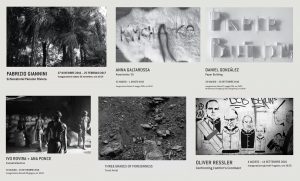Foreignness
Foreignness (2016-2018) è un neologismo che in italiano suonerebbe come “estericità” ovvero estraneità, un nuovo termine che vuol far emergere le diverse forme e modalità di sentirsi estraneo, diverso, non più appartenente, e conseguentemente avulso da un determinato contesto in costante evoluzione.L’attività progettuale, così come impostata di “festival delle arti”, potrà fungere da polo di aggregazione sociale e di condivisione, e in concreto interagire così con la realtà locale, per confrontarsi con essa mediante un’offerta proveniente dal basso, al fine di facilitare quel processo partecipativo inteso come motore di indotto economico e culturale per possibilmente ricreare un contesto di sviluppo urbano nel quale riconoscersi.Il programma presente, passato e futuro e le conseguenti scelte curatoriali specifiche adottate in termini di artisti invitati e di creazione artistica conseguente si estrinsecherà ovviamente anche sugli equilibri tra offerta artistica di provenienza locale e d’oltre frontiera, nella certezza che solo un processo di apertura e confronto può mettere in risalto e preservare il patrimonio culturale locale. Come si può evincere dunque le attività programmatiche tratteranno da diverse angolature il concetto di estraneità, nell’intento di ricreare, mediante l’attività artistica nel più ampio senso del termine quel processo di riappropriazione e salvaguardia del patrimonio culturale locale, dando inizio a un’azione di ricontestualizzazione programmatica di tutti quei fattori, quali stimolo di appartenenza a un progetto comune.
The term foreignness [estericità] involves numerous ways of feeling foreign, different, not belonging, and consequently detached from a constantly evolving environment.
The activity related to the project, which is set up as an “arts festival”, could become a focal point for social gathering and sharing and concretely interact with the local reality, in order to compare with it, through a bottom-up approach, with the aim of facilitating the participatory process intended as an engine of economic and cultural activities and possibly recreate a context of urban development with which it is possible to identify.
The present, past and future programme and the resulting curatorial choices adopted, in terms of artists invited and artistic creation, will express themselves also in the equilibrium between the local artistic offer and the foreign one, in the certainty that only a process of opening and comparison can highlight and preserve the local cultural heritage. Therefore, as it is possible to understand, the activities that will be part of the programme will deal with the concept of foreignness from different angles, with the aim of recreating, through artistic activity in the broad sense of the term, the process of reappropriation and preservation of local cultural heritage, thus beginning a programmatic recontextualisation of all those factors as an incentive of a common sense of belonging.

